Each of the given beakers contains two metal strips of same size fastened together and immersed in hydrochloric acid. After some time, which beaker will contain the least amount of zinc ions?

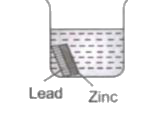
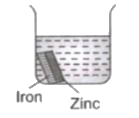
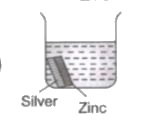
The correct Answer is:A
To solve the question, we need to analyze the reactivity of the metals involved and how they interact with hydrochloric acid (HCl). The question asks which beaker will contain the least amount of zinc ions after the reaction has taken place.
1. Identify the Metals: We have two metal strips in each beaker, and we need to consider their reactivity with hydrochloric acid. The metals mentioned are magnesium and zinc.
2. Understand Reactivity: Reactivity series indicates that magnesium is more reactive than zinc. This means that magnesium will react more readily with hydrochloric acid compared to zinc.
3. Reaction with Hydrochloric Acid: When magnesium reacts with hydrochloric acid, it will produce magnesium ions and hydrogen gas. The reaction can be represented as:
Mg+2HCl→Mg2++2Cl−+H2
Zinc will also react with hydrochloric acid, producing zinc ions and hydrogen gas:
Zn+2HCl→Zn2++2Cl−+H2
4. Comparing the Reactions: Since magnesium is more reactive than zinc, in a beaker where magnesium is present, it will react with hydrochloric acid first and more vigorously than zinc. This means that in the beaker with magnesium, zinc will not have the opportunity to react as much because the magnesium will consume the acid.
5. Conclusion: Therefore, the beaker that contains magnesium along with zinc will have the least amount of zinc ions produced because the magnesium will react with the hydrochloric acid before zinc can react significantly.
Final Answer:
The beaker containing magnesium will have the least amount of zinc ions.
---
Mg+2HCl→Mg2++2Cl−+H2
Zinc will also react with hydrochloric acid, producing zinc ions and hydrogen gas:
Zn+2HCl→Zn2++2Cl−+H2
The beaker containing magnesium will have the least amount of zinc ions.
Topper's Solved these Questions
- METALS AND NON-METAL BOOK - SCIENCE OLYMPIAD FOUNDATION CHAPTER - METALS AND NON-METAL EXERCISE - ACHIEVERS SECTION (HOTS)
5 Videos
- COMBUSTION AND FLAMEBOOK - SCIENCE OLYMPIAD FOUNDATION CHAPTER - COMBUSTION AND FLAMEEXERCISE - MULTIPLE CHOICE QUESTION (ACHIEVERS SECTION (HOTS))
5 Videos
- NSO MODEL TEST PAPER -1BOOK - SCIENCE OLYMPIAD FOUNDATION CHAPTER - NSO MODEL TEST PAPER -1EXERCISE - ACHIEVERS SECTION
1 Videos
Similar Questions
Abhinav is a student of class IX. One day all the students were performing experiments in the science laboratory. Just then, the chemistry teacher, Mrs. Prasad, came to the laboratory. She had three beaker in her hands labelled A, B and C. All the beakers contained colourless liquids which looked exactly the same. Mrs. Prasad turned to the students and said that one of the beakers contained a pure substance whereas the other two beakers contained solutions of the same solute in the same solvent but different concentrations. She also told the students that the weight one of the three beakers A, B and C were 110g, 120g and 100g respectively. Mrs. Prasad wanted one of the students to find out experiementally which beaker contained a pure substance and which two beakers contained solutions. She also wanted them to show experimentally two properties which could tell why the solutions are considered mixtures, even though they are homogeneous substances. Mrs. Prasad wanted one of the the students to find out experimentally which beaker contained a pure substance and which two beakers contained solutions. She also wanted them to show experimentally two properties which could tell why the solutions are considered mixtures, even though they are homogeneous substances. Mrs. Prasad allowed them to use any required apparatus from the laboratory for the purpose. Abhinav offered to perform the experiements to distinguish between the pure substance and solutions and also to show experimentally why solutions are considered mixtures.
(a) What did Abhinav do to find out which of the given liquids is a pure substances and which liquids are solutions ? What were the observations made by Abhinav ?
(b) Whay did Abhinav conclude form the above observations ?
(c) Which property of the pure substance is exhibited by this experiment ?
(d) Which properties of a solution are exhibited in this experiement ?
(e) What values are displayed by Abhinav in this episode ?
View SolutionA beaker contains hot water we will notice that after some time rate of heat decreases. Why is it so happens?
View Solution
Knowledge Check
Each beaker shown in the given options, contains two same sizes strips of different metals fastened together and immersed in hydrochloric acid. After 5 minutes, which beaker will contain the least amount of zinc ions ?
A B
B C
C D
D
Each of the given beakers contains two metal strips of same size fastened together and immersed in in hydrochloric acid.

After 5 minutes, amount of Q ions formed is greater than P ions in beaker 1, S ions is greater than R ions in beaker 2, R ions is greater than Q ions in beaker 3, and T ions is greater than S ions in beaker 4.
Correct order of reactiivity of these metals isAP>Q>R>S>TBR<P<T<S<QCT>R>Q>P>SDP<Q<R<S<TThe beakers shown contain equal amounts of water and another material. Which list shows the solubility of the different materials in the beakers, from most to least soluble
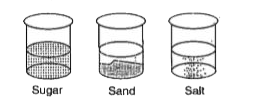 Asalt, sand, sugarBsalt, sugar, sandCsand, salt, sugarDsugar, salt, sand
Asalt, sand, sugarBsalt, sugar, sandCsand, salt, sugarDsugar, salt, sand
Metals in general have a tendency to evolve hydrogen gas o reacting with acids. In the activity series the metals that are placed above hydrogen evolve the gas on reaction with acids while the metals placed below hydrogen do not evolve the gas on reaction with acids. these metals are regarded as inactive metals. metals placed at the bottom of the series are called noble metals.
Pieces of copper, lead, aluminium and zinc are added to dilute hydrochloric acid. which of the following test tubes most likely contains zinc ?

View SolutionThe statement below is followed by two conclusions labelled I and II.
Decide which conclusion(s) logically and definitely follow(s) from the information given in the statement only.
Statement:
Rain water is the purest form of water.
Conclusions:
I. Rain water contains impurities.
II. Rain water will contain the least amount of impurities.
View SolutionEach of the three beakers A, B, and C contained 50 mL of distilled water. A student placed five reisins in each beaker. The raisins for each beaker weighed the same. The beakers were kept at room temperature. The raisins were removed from beaker A after 10 minutes, from beaker B after 20 minutes and from beaker C after one hour. On calculating the percentage of water absorbed by the raisins, it was found that:
View SolutionObserve the following diagram and answer any four questions from (i) and (v) given below.
During an experiment, Rehana took three beakers A, B and C filled with aqueous solutions of glucose, alcohol and hydrochloric acid respectively as shown in the following figure :

If the property of ion formation is considered, which of the following options is correct ?
View SolutionThere are two cylinder shaped wooden billets, each having a mass of mass 45kg, in a vertical wall sewage, which contains water in it. the two billets have the same size and the same material, they touch each other and the walls of the sewage. One of them is totally under the water, whilst only half of the other one is immersed into the water. Friction is negligible everywhere. (density of water is 1000kg/m3 and g=10m/s2). Choose the correct option(s)
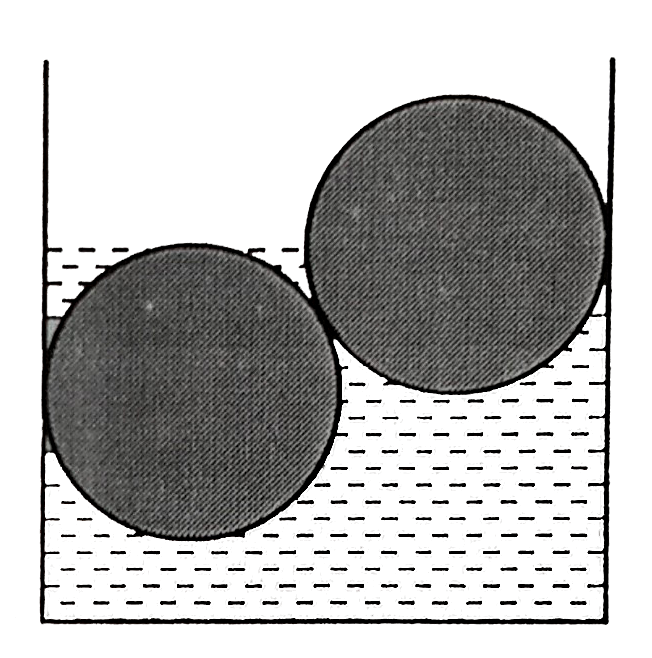
View Solution
